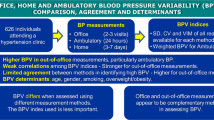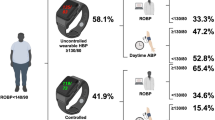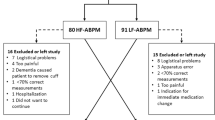Abstract
Although it is known that reproducibility of ambulatory blood pressure (BP) is superior to office BP in middle-aged subjects, little is known in older age groups. Hence, we compared the long-term reproducibility of ambulatory and office BP readings in subjects over the age of 75 years. A cohort of 72 subjects 75–90 years of age (mean, 82 years at baseline) had repeat office and ambulatory BPs 2 years apart under similar conditions. On the same day, patients underwent office BP measurements by a semi-automated device and then by ambulatory BP monitoring. Awake and sleep periods were divided according to a diary kept by each patient. The agreement between studies was assessed using the standard deviation of the differences (SDD) and Bland–Altman plots. There were minimal mean changes in office, 24-h, and awake and sleep mean BP values between baseline and 2 years later. The SDDs between visits were lower for 24-h BP compared with the office BP (11.7/5.9 mm Hg versus 17.8/9.0 mm Hg, P<0.01). The SDD for 24-h BP was also lower than the SDDs for the awake and sleep BP (P<0.05). Nocturnal BPs defined by absolute values were more reproducible than categories of dippers and non-dippers. These data demonstrate that long-term reproducibility of 24-h BP is superior to office measurements for very elderly subjects. In a clinical trial involving this age group, far fewer subjects would be required if 24-h BP was the primary efficacy endpoint rather than the office BP.
This is a preview of subscription content, access via your institution
Access options
Subscribe to this journal
Receive 12 digital issues and online access to articles
$119.00 per year
only $9.92 per issue
Buy this article
- Purchase on Springer Link
- Instant access to full article PDF
Prices may be subject to local taxes which are calculated during checkout

Similar content being viewed by others
References
Trazzi S, Mutti E, Frattola A, Imholz B, Parati G, Mancia G . Reproducibility of non-invasive and intra-arterial blood pressure monitoring: implications for studies on antihypertensive treatment. J Hypertens 1991; 9: 115–119.
Des Combes BJ, Porchet M, Waeber B, Brunner HR . Ambulatory blood pressure recordings reproducibility and unpredictability. Hypertension 1984; 6: 110–114.
James GD, Pickering TG, Yee LS, Harshfield GA, Riva S, Laragh JH . The reproducibility of average ambulatory, home and clinic pressures. Hypertension 1988; 11: 545–549.
Conway J, Johnston J, Coats A, Somers V, Sleight P . The use of ambulatory blood pressure monitoring to improve the accuracy and reduce the numbers of subjects in clinical trials of antihypertensive agents. J Hypertens 1988; 6: 111–116.
Mansoor GA, McCabe EJ, White WB . Long-term reproducibility of ambulatory blood pressure. J Hypertens 1994; 12: 703–708.
Wizner B, Dechering DG, Thijs L, Atkins N, Fagard R, O’Brien E et al. Short-term and long-term repeatability of the morning blood pressure in older patients with isolated systolic hypertension. J Hypertens 2008; 26: 1328–1335.
Beckett NS, Peters R, Fletcher AE, Staessen JA, Liu L, Dumitrascu D et al. Treatment of hypertension in patients 80 years of age or older. N Engl J Med 2008; 358: 1887–1898.
Burr ML, Dolan E, O’Brien EW, O’Brien ET, McCormack P . The value of ambulatory blood pressure in older adults: the Dublin outcome study. Age Ageing 2008; 37: 201–206.
Staessen JA, Thijs L, Fagard R, O’Brien ET, Clement D, de Leeuw PW et al. Predicting cardiovascular risk using conventional vs ambulatory blood pressure in older patients with systolic hypertension. JAMA 1999; 282: 539–546.
Bjorklund K, Lind L, Zethelius B, Berglund L, Lithell H . Prognostic significance of 24-h ambulatory blood pressure characteristics for cardiovascular morbidity in a population of elderly men. J Hypertens 2004; 22: 1691–1697.
Khattar RS, Swales JD, Dore C, Senior R, Lahiri A . Effect of aging on the prognostic significance of ambulatory systolic, diastolic and pulse pressure in essential hypertension. Circulation 2001; 104: 783–789.
Moscufo N, Guttmann CR, Meier D, Csapo I, Hildenbrand PG, Healy BC et al. Brain regional lesion burden and impaired mobility in the elderly. Neurobiol Aging 2009 (e-pub ahead of print).
Goodwin J, Bilous M, Winship S, Finn P, Jones SC . Validation of the Oscar 2 oscillometric 24-h ambulatory blood pressure monitor according to the British Hypertension Society protocol. Blood Pressure Monit 2007; 12: 113–117.
Bland JM, Altman DG . Statistical methods for assessing agreement between two methods of clinical measurement. Lancet 1986; 1: 307–311.
Pitman EJG . A note on normal correlation. Biometrika 1939; 31: 9–12.
White WB, Larocca G . Improving the utility of the nocturnal hypertension definition by using absolute sleep blood pressure rather than the ‘Dipping’ proportion. Am J Cardiol 2003; 92: 1439–1441.
Palatini P, Mormino P, Canali C, Santonastaso M, De Venuto G, Zanata G et al. Factors affecting ambulatory blood pressure reproducibility: Results of the HARVEST Trial. Hypertension 1994; 23: 211–216.
Kario K, Ishikawa J, Pickering TG, Hoshide S, Eguchi K, Morinari M et al. Morning hypertension: the strongest independent risk factor for stroke in elderly hypertensive patients. Hypertens Res 2006; 29: 581–587.
Metoki H, Ohkubo T, Kikuya M, Asayama K, Obara T, Hara A et al. Prognostic significance of night-time, early morning and daytime blood pressures on the risk of cerebrovascular mortality: the Ohasama Study. J Hypertens 2006; 24: 1841–1848.
Omboni S, Parati G, Palatini P, Vanasia A, Muiesan ML, Cuspidi C et al. Reproducibility and clinical value of nocturnal hypotension: prospective evidence from the SAMPLE study. J Hypertens 1998; 16: 733–738.
Cuspidi C, Meani S, Valerio C, Sala C, Fusi V, Masaidi M et al. Reproducibility of dipping/non-dipping pattern in untreated essential hypertensive patients: impact of sex and age. Blood Press Monit 2007; 12: 101–106.
Mancia G, Bombelli M, Facchetti R, Madotto F, Corrao G, Quarti Trevano F et al. Long-term prognostic value of blood pressure variability in the general population: Results of the Pressioni Arteriose Monitirate e Loro Associazioni Study. Hypertension 2007; 49: 1265–1270.
Acknowledgements
This work was funded by NIH RO1 AG022092, NIH 5R01 DA24667-2 and the University of Connecticut Clinical Trials Unit.
Author information
Authors and Affiliations
Corresponding author
Ethics declarations
Competing interests
The authors declare no conflict of interest.
Rights and permissions
About this article
Cite this article
Campbell, P., Ghuman, N., Wakefield, D. et al. Long-term reproducibility of ambulatory blood pressure is superior to office blood pressure in the very elderly. J Hum Hypertens 24, 749–754 (2010). https://doi.org/10.1038/jhh.2010.8
Received:
Revised:
Accepted:
Published:
Issue Date:
DOI: https://doi.org/10.1038/jhh.2010.8
Keywords
This article is cited by
-
Optimize antihypertensive treatment in older individuals by using a decision framework
Drugs & Therapy Perspectives (2020)
-
Going Beyond the Guidelines in Individualising the Use of Antihypertensive Drugs in Older Patients
Drugs & Aging (2019)
-
Efficacy and safety of azilsartan medoxomil, an angiotensin receptor blocker, in Korean patients with essential hypertension
Clinical Hypertension (2018)
-
Cardiovascular risk factors and small vessel disease of the brain: Blood pressure, white matter lesions, and functional decline in older persons
Journal of Cerebral Blood Flow & Metabolism (2016)
-
A meta-analysis of randomized controlled trials of azilsartan therapy for blood pressure reduction
Hypertension Research (2014)



